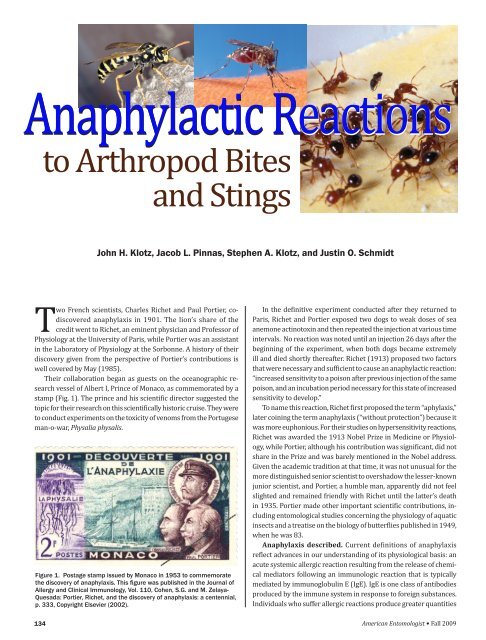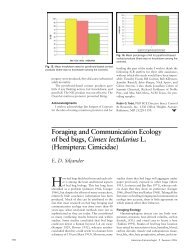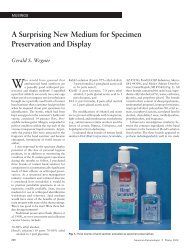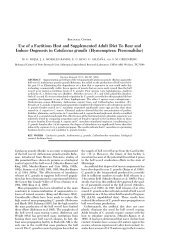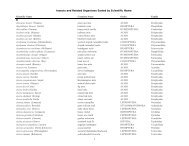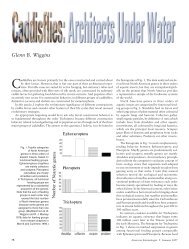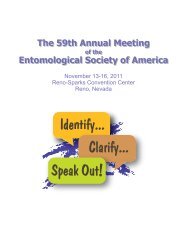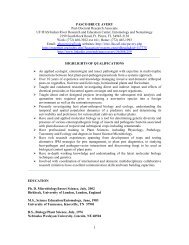to Arthropod Bites and Stings - Entomological Society of America
to Arthropod Bites and Stings - Entomological Society of America
to Arthropod Bites and Stings - Entomological Society of America
Create successful ePaper yourself
Turn your PDF publications into a flip-book with our unique Google optimized e-Paper software.
Anaphylactic Reactions<br />
<strong>to</strong> <strong>Arthropod</strong> <strong>Bites</strong><br />
<strong>and</strong> <strong>Stings</strong><br />
John H. Klotz, Jacob L. Pinnas, Stephen A. Klotz, <strong>and</strong> Justin O. Schmidt<br />
Two French scientists, Charles Richet <strong>and</strong> Paul Portier, codiscovered<br />
anaphylaxis in 1901. The lion’s share <strong>of</strong> the<br />
credit went <strong>to</strong> Richet, an eminent physician <strong>and</strong> Pr<strong>of</strong>essor <strong>of</strong><br />
Physiology at the University <strong>of</strong> Paris, while Portier was an assistant<br />
in the Labora<strong>to</strong>ry <strong>of</strong> Physiology at the Sorbonne. A his<strong>to</strong>ry <strong>of</strong> their<br />
discovery given from the perspective <strong>of</strong> Portier’s contributions is<br />
well covered by May (1985).<br />
Their collaboration began as guests on the oceanographic research<br />
vessel <strong>of</strong> Albert I, Prince <strong>of</strong> Monaco, as commemorated by a<br />
stamp (Fig. 1). The prince <strong>and</strong> his scientific direc<strong>to</strong>r suggested the<br />
<strong>to</strong>pic for their research on this scientifically his<strong>to</strong>ric cruise. They were<br />
<strong>to</strong> conduct experiments on the <strong>to</strong>xicity <strong>of</strong> venoms from the Portugese<br />
man-o-war, Physalia physalis.<br />
Figure 1. Postage stamp issued by Monaco in 1953 <strong>to</strong> commemorate<br />
the discovery <strong>of</strong> anaphylaxis. This figure was published in the Journal <strong>of</strong><br />
Allergy <strong>and</strong> Clinical Immunology, Vol. 110, Cohen, S.G. <strong>and</strong> M. Zelaya-<br />
Quesada: Portier, Richet, <strong>and</strong> the discovery <strong>of</strong> anaphylaxis: a centennial,<br />
p. 333, Copyright Elsevier (2002).<br />
In the definitive experiment conducted after they returned <strong>to</strong><br />
Paris, Richet <strong>and</strong> Portier exposed two dogs <strong>to</strong> weak doses <strong>of</strong> sea<br />
anemone actino<strong>to</strong>xin <strong>and</strong> then repeated the injection at various time<br />
intervals. No reaction was noted until an injection 26 days after the<br />
beginning <strong>of</strong> the experiment, when both dogs became extremely<br />
ill <strong>and</strong> died shortly thereafter. Richet (1913) proposed two fac<strong>to</strong>rs<br />
that were necessary <strong>and</strong> sufficient <strong>to</strong> cause an anaphylactic reaction:<br />
“increased sensitivity <strong>to</strong> a poison after previous injection <strong>of</strong> the same<br />
poison, <strong>and</strong> an incubation period necessary for this state <strong>of</strong> increased<br />
sensitivity <strong>to</strong> develop.”<br />
To name this reaction, Richet first proposed the term “aphylaxis,”<br />
later coining the term anaphylaxis (“without protection”) because it<br />
was more euphonious. For their studies on hypersensitivity reactions,<br />
Richet was awarded the 1913 Nobel Prize in Medicine or Physiology,<br />
while Portier, although his contribution was significant, did not<br />
share in the Prize <strong>and</strong> was barely mentioned in the Nobel address.<br />
Given the academic tradition at that time, it was not unusual for the<br />
more distinguished senior scientist <strong>to</strong> overshadow the lesser-known<br />
junior scientist, <strong>and</strong> Portier, a humble man, apparently did not feel<br />
slighted <strong>and</strong> remained friendly with Richet until the latter’s death<br />
in 1935. Portier made other important scientific contributions, including<br />
en<strong>to</strong>mological studies concerning the physiology <strong>of</strong> aquatic<br />
insects <strong>and</strong> a treatise on the biology <strong>of</strong> butterflies published in 1949,<br />
when he was 83.<br />
Anaphylaxis described. Current definitions <strong>of</strong> anaphylaxis<br />
reflect advances in our underst<strong>and</strong>ing <strong>of</strong> its physiological basis: an<br />
acute systemic allergic reaction resulting from the release <strong>of</strong> chemical<br />
media<strong>to</strong>rs following an immunologic reaction that is typically<br />
mediated by immunoglobulin E (IgE). IgE is one class <strong>of</strong> antibodies<br />
produced by the immune system in response <strong>to</strong> foreign substances.<br />
Individuals who suffer allergic reactions produce greater quantities<br />
134 <strong>America</strong>n En<strong>to</strong>mologist • Fall 2009
<strong>of</strong> IgE <strong>to</strong>ward allergens <strong>to</strong> which they have been sensitized <strong>and</strong> have<br />
poorer regulation <strong>of</strong> responses <strong>to</strong> those allergens.<br />
A sensitization phase in which the individual is “set up” for the<br />
reaction (Frazier <strong>and</strong> Brown 1980) directs lymphocytes <strong>to</strong> recognize<br />
invading allergens as foreign <strong>and</strong> activates them <strong>to</strong> produce IgEantibodies.<br />
The lymphocytes then release these antibodies, which<br />
subsequently bind <strong>to</strong> recep<strong>to</strong>r sites on mast cells <strong>and</strong> circulating<br />
basophils. The mast cells contain histamine <strong>and</strong> are located in body<br />
tissues such as the respira<strong>to</strong>ry <strong>and</strong> gastrointestinal tracts, the heart,<br />
<strong>and</strong> the mucous gl<strong>and</strong>s <strong>and</strong> skin.<br />
In the sensitized individual, re-exposure <strong>to</strong> the <strong>of</strong>fending allergen<br />
sets in motion a cascade <strong>of</strong> biochemical events. The allergen crosslinks<br />
neighboring IgE antibodies on mast cell <strong>and</strong> basophil surfaces,<br />
which alters the cell membrane <strong>and</strong> leads <strong>to</strong> the release <strong>of</strong> histamine<br />
<strong>and</strong> other chemical media<strong>to</strong>rs. These media<strong>to</strong>rs are capable <strong>of</strong><br />
contracting smooth muscle in the airways <strong>and</strong> intestines, as well as<br />
dilating blood vessels <strong>and</strong> increasing vascular permeability.<br />
These pathophysiological events may manifest as hives or skin<br />
swellings (angiodema), labored breathing, dizziness, or shock.<br />
The time interval between a bite or sting <strong>and</strong> appearance <strong>of</strong> these<br />
symp<strong>to</strong>ms is <strong>of</strong>ten short, usually only several minutes. Reactions <strong>to</strong><br />
stings by Hymenoptera, for example, vary within a continuum ranging<br />
from minor <strong>to</strong> severe. In most cases the reaction is limited <strong>to</strong> a<br />
welt (hive)—a reddened, tender area that causes burning <strong>and</strong> pain<br />
for an hour or two (Greene 2005). In a large local reaction, there is<br />
pronounced swelling; sometimes an entire leg or arm will swell from<br />
a sting on the <strong>to</strong>e or finger.<br />
The most common systemic reactions are cutaneous: the individual<br />
breaks out in hives or urticaria. There is the rare fatal anaphylactic<br />
reaction, in which the individual typically dies within 30<br />
<strong>to</strong> 60 minutes after the sting due <strong>to</strong> respira<strong>to</strong>ry <strong>and</strong> cardiovascular<br />
complications. These are not <strong>to</strong>xic reactions, but allergic reactions<br />
<strong>to</strong> proteins in the venom (<strong>to</strong>xic reactions take hours <strong>to</strong> days, unless<br />
several thous<strong>and</strong>s <strong>of</strong> stings are received).<br />
Causative agents <strong>of</strong> Anaphylaxis. Since its discovery in the early<br />
1900s, other causative agents <strong>of</strong> anaphylaxis in addition <strong>to</strong> venom<br />
have been implicated, including foods, which are the most common<br />
cause <strong>of</strong> anaphylaxis outside <strong>of</strong> the hospital setting (50-100 deaths/<br />
year), medications (especially antibiotics), latex, vaccines, hormones,<br />
<strong>and</strong> sometimes even exercise when associated with a particular food<br />
(Kemp 2001; Fireman 1999).<br />
<strong>Arthropod</strong>s are by far the most common cause <strong>of</strong> anaphylaxis<br />
due <strong>to</strong> animal bites or stings, <strong>and</strong> the insects (particularly Hymenoptera)<br />
make up the majority <strong>of</strong> these cases (see Table 1 for cases <strong>of</strong><br />
anaphylaxis caused by arthropods that have been determined <strong>to</strong> be<br />
IgE-mediated <strong>and</strong> Table 2 for other reported cases <strong>of</strong> anaphylacticlike<br />
reactions, so called because these reports lack the definitive in<br />
vitro or in vivo tests <strong>to</strong> demonstrate IgE-mediation).<br />
Insects<br />
Hymenoptera. It is speculated that the earliest case <strong>of</strong> an allergic<br />
reaction dates back <strong>to</strong> ancient Egypt (3300 <strong>to</strong> 2640 BCE), when the<br />
Pharaoh Menes supposedly suffered a fatal anaphylactic reaction<br />
when stung by a “kheb” during a journey <strong>to</strong> the “Western Isles”—possibly<br />
referring <strong>to</strong> Britain (Harper 1980). In ancient Egyptian, kheb<br />
means hornet or hippopotamus, <strong>and</strong> <strong>to</strong> the dismay <strong>of</strong> the allergists<br />
who favor this his<strong>to</strong>rical footnote as <strong>to</strong> the origin <strong>of</strong> their pr<strong>of</strong>ession,<br />
some Egyp<strong>to</strong>logists have implicated the hippo in the death <strong>of</strong> King<br />
Menes, especially given its abundance in the Nile (Harper 1980).<br />
Table 1. Anaphylactic reactions <strong>to</strong> arthropod bites <strong>and</strong> stings (evidence<br />
for IgE-mediation) (Klotz et al. 2008)<br />
Scientific Nomenclature (Common names in parentheses were reported<br />
<strong>to</strong> induce the reaction)<br />
Phylum: <strong>Arthropod</strong>a<br />
Class: Insecta<br />
Order: Hymenoptera<br />
Family: Vespidae<br />
Genus: Vespula (ground-nesting yellow jackets)<br />
Dolichovespula (aerial-nesting yellow jackets)<br />
Vespa (hornets)<br />
Polistes (paper wasps)<br />
Family: Apidae<br />
Genus: Apis (honey bees)<br />
Bombus (bumble bees)<br />
Family: Formicidae<br />
Genus: Solenopsis (fire ants)<br />
Pogonomyrmex (harvester ants)<br />
Tetramorium<br />
Myrmecia (bulldog ants)<br />
Pachycondyla (Asian needle <strong>and</strong> Samsum ants)<br />
Formica (wood ants)<br />
Order: Hemiptera<br />
Family: Reduviidae<br />
Genus: Tria<strong>to</strong>ma (kissing bugs)<br />
Order: Diptera<br />
Family: Tabanidae<br />
Genus: Chrysops (deer flies)<br />
Tabanus (horse flies)<br />
Family: Simuliidae (black flies)<br />
Culicidae (mosqui<strong>to</strong>es)<br />
Hippoboscidae (louse flies)<br />
Muscidae<br />
Genus: Glossina (tsetse flies)<br />
Order: Lepidoptera<br />
Family: No<strong>to</strong>dontidae<br />
Genus: Thaume<strong>to</strong>poea (pine processionary caterpillars)<br />
Class: Arachnida<br />
Order: Acari<br />
Family: Ixodidae<br />
Genus: Ixodes holocyclus (Australian paralysis ticks)<br />
Ixodes pacificus (western black-legged ticks)<br />
Ixodes ricinus<br />
Rhiphicephalus<br />
Family: Argasidae<br />
Genus: Argas (pigeon ticks)<br />
Order: Scorpiones<br />
Genus: Centruroides (bark <strong>and</strong> common striped scorpions)<br />
Class: Chilopoda (centipedes)<br />
About 1% <strong>of</strong> children <strong>and</strong> 3% <strong>of</strong> adults are allergic <strong>to</strong> stings <strong>of</strong><br />
Hymenoptera, <strong>and</strong> at least 40 fatalities occur each year in the United<br />
States, with many victims having no previous reactions <strong>to</strong> stings<br />
(Golden 2003). Sting allergies in the U.S. are most commonly due <strong>to</strong><br />
yellow jackets (Vespula <strong>and</strong> Dolichovespula) <strong>and</strong> honey bees (Apis),<br />
followed by fire ants (Solenopsis) <strong>and</strong> paper wasps (Polistes), <strong>and</strong> less<br />
frequently, harvester ants (Pogonomyrmex), hornets (Vespa), bumblebees<br />
(Bombus), <strong>and</strong> sweat bees (Halictidae) (Schmidt 1992).<br />
All <strong>of</strong> these insects, except some sweat bees, are social <strong>and</strong> most<br />
are characterized by central place foraging: worker bees, wasps, <strong>and</strong><br />
ants leave a nest <strong>to</strong> find food <strong>and</strong> then return with it <strong>to</strong> provide for<br />
the colony. The distance traveled <strong>to</strong> obtain food varies from a few<br />
meters for ants <strong>to</strong> several kilometers for bees. The daily range <strong>of</strong><br />
the colony’s forays defines its home range or terri<strong>to</strong>ry. As the colony<br />
grows in size, its terri<strong>to</strong>ry exp<strong>and</strong>s <strong>to</strong> accommodate the increasing<br />
<strong>America</strong>n En<strong>to</strong>mologist • Volume 55, Number 3 135
Table 2. Anaphylactic-like reactions <strong>to</strong> bites <strong>and</strong> stings <strong>of</strong> arthropods<br />
(lacking labora<strong>to</strong>ry evidence for IgE-mediation) (Klotz et al. 2008)<br />
Scientific Nomenclature (Common names in parentheses were reported<br />
<strong>to</strong> induce the reaction)<br />
Phylum: <strong>Arthropod</strong>a<br />
Class: Insecta<br />
Order: Hymenoptera<br />
Family: Halictidae (sweat bees)<br />
Formicidae<br />
Genus: Pseudomyrmex (twig ants)<br />
Hypoponera<br />
Rhytidoponera (green-head ants)<br />
Order: Hemiptera<br />
Family: Cimicidae<br />
Genus: Cimex (bed bugs)<br />
Order: Diptera<br />
Family: Cera<strong>to</strong>pogonidae<br />
Genus: Culicoides (punkies)<br />
Family: Rhagionidae<br />
Genus: Symphoromyia (snipe flies)<br />
Family: Therevidae<br />
Genus: Thereva (stilet<strong>to</strong> flies)<br />
Order: Lepidoptera<br />
Family: Anthelidae<br />
Genus: Chelepteryx (white-stemmed gum moths)<br />
Family: Megalopygidae<br />
Genus: Megalopyge (puss caterpillars)<br />
numbers <strong>of</strong> individuals. Their terri<strong>to</strong>rial defense is maximal at the<br />
nest, which they tenaciously defend against any intruder.<br />
In the aculeate Hymenoptera (wasps, bees, <strong>and</strong> ants), the oviposi<strong>to</strong>r<br />
<strong>of</strong> females has been modified in<strong>to</strong> a stinger, an adaptation that<br />
enables these insects <strong>to</strong> defend their nest against potential preda<strong>to</strong>rs<br />
that would exploit such a concentrated source <strong>of</strong> food (Schmidt<br />
1986). In many species <strong>of</strong> ants the stinger is absent or vestigial, but<br />
they still possess potent defensive secretions.<br />
Although ants are not generally appreciated as causes <strong>of</strong> anaphylaxis,<br />
there are a growing number <strong>of</strong> species in the U.S. that have been<br />
reported <strong>to</strong> cause this medical emergency (Table 3). Most no<strong>to</strong>rious<br />
is the red imported fire ant, Solenopsis invicta, which is widespread<br />
in the southeastern U.S. <strong>and</strong> continuing <strong>to</strong> exp<strong>and</strong> its range. In some<br />
infested urban areas > 50% <strong>of</strong> the population is stung per year (de<br />
Shazo et al. 1990) <strong>and</strong> as much as 17% <strong>of</strong> the population is sensitized<br />
(Caplan et al. 2003). At least 80 deaths have been attributed<br />
<strong>to</strong> imported fire ants (Rhoades et al. 1989). Particularly vulnerable<br />
are the elderly <strong>and</strong> infirm in nursing homes or hospitals, unable <strong>to</strong><br />
defend themselves from attack because <strong>of</strong> limited mobility.<br />
Infants represent another vulnerable group <strong>to</strong> fire ant stings.<br />
Two fatalities attributed <strong>to</strong> southern fire ants, Solenopsis xyloni, were<br />
babies less than a year old (Coarsey 1952; Klotz et al. 2004). Nonfatal<br />
systemic reactions have been reported for two other native fire ant<br />
species, S. aurea <strong>and</strong> S. geminata (H<strong>of</strong>fman 1997), although the native<br />
fire ants are generally less aggressive than imported fire ants.<br />
Fire ant stings are characterized by an intense burning sensation<br />
due <strong>to</strong> alkaloid compounds (piperidines) in the venom. Each species<br />
has its own unique blend <strong>of</strong> these compounds, but imported fire<br />
ant stings are the most severe <strong>and</strong> typically cause the formation <strong>of</strong><br />
pseudopustules.<br />
Harvester ants possess the most <strong>to</strong>xic <strong>of</strong> all insect venoms; in<br />
fact, drop for drop, it is more <strong>to</strong>xic than rattlesnake venom (Schmidt<br />
Table 3. Ant species <strong>and</strong> their geographic distribution in the continental<br />
U.S. that have been reported <strong>to</strong> cause anaphylactic or anaphylactic-like<br />
reactions (Klotz et al. 2005b)<br />
Scientific Name Range<br />
Solenopsis invicta Southern US, New Mexico, California<br />
Solenopsis xyloni Southern <strong>and</strong> southwestern US<br />
Solenopsis aurea Southwestern US<br />
Solenopsis geminata Southern US<br />
Pogonomyrmex rugosus Western Texas <strong>and</strong> Oklahoma in<strong>to</strong><br />
southern California<br />
Pogonomyrmex maricopa West Texas in<strong>to</strong> southern California<br />
Pogonomyrmex barbatus Kansas south <strong>to</strong> Texas in<strong>to</strong> Arizona<br />
Pseudomyrmex ejectus Southern US<br />
Hypoponera punctatissima Florida, Northeast, Pacific Northwest<br />
Pachycondyla chinensis Georgia <strong>to</strong> Virginia<br />
1978). The sting has been described as “ripping muscles or tendons”<br />
<strong>and</strong> “turning a screw in the flesh” (Schmidt 1986). A neuro<strong>to</strong>xic component<br />
in the venom causes gooseflesh <strong>and</strong> sweating <strong>to</strong> occur at the<br />
sting site, <strong>and</strong> <strong>of</strong>ten victims develop pain <strong>and</strong> tenderness in nearby<br />
lymph nodes. Allergic reactions <strong>to</strong> the sting have been reported.<br />
For example, <strong>of</strong> eight patients treated for stings over a one-year<br />
period in Tucson, Arizona, four had large local reactions, <strong>and</strong> four<br />
were treated for anaphylaxis (Pinnas et al. 1977). The two species<br />
responsible, the Maricopa harvester ant, Pogonomyrmex maricopa,<br />
<strong>and</strong> the rough harvester ant, P. rugosus, are commonly found in urban<br />
areas <strong>of</strong> Tucson (Klotz et al. 2005a). Schmidt et al. (1984) determined<br />
that there was significant cross-sensitivity <strong>of</strong> patients <strong>to</strong> the various<br />
species <strong>of</strong> harvester ants.<br />
Isolated cases <strong>of</strong> anaphylactic <strong>and</strong> anaphylactic-like reactions<br />
have been reported in the U.S. for ants belonging <strong>to</strong> several genera.<br />
One case reported from South Carolina resulted from the sting <strong>of</strong> an<br />
unidentified species <strong>of</strong> Tetramorium (Majeski et al. 1974). Two cases<br />
in the southeast were due <strong>to</strong> stings by Pseudomyrmex ejectus (Klotz<br />
et al. 2005b), a twig-inhabiting ant that lives in small colonies with<br />
typically
This species does not have a sting; nevertheless, it caused an anaphylactic<br />
reaction through its bite (Schmid-Grendelmeier 1997). In addition<br />
<strong>to</strong> biting, ants in this genus spray formic acid that is produced<br />
in the venom gl<strong>and</strong> along with other compounds.<br />
Hemiptera. In comparison <strong>to</strong> the stinging Hymenoptera, biting<br />
insects cause far fewer allergic reactions. By far the most frequent in<br />
the U.S. are allergic reactions <strong>to</strong> bites from kissing bugs (Tria<strong>to</strong>ma <strong>and</strong><br />
Paratria<strong>to</strong>ma spp.). For example, in one small community in Santa<br />
Barbara County, California, about 7% <strong>of</strong> the population has been<br />
sensitized <strong>to</strong> bites <strong>of</strong> the western conenose bug, Tria<strong>to</strong>ma protracta<br />
(Marshall et al. 1986). Another species, T. rubida, is more common<br />
in central <strong>and</strong> southern Arizona <strong>and</strong> is particularly a problem in the<br />
foothills <strong>of</strong> Tucson, where most <strong>of</strong> the allergic reactions are reported<br />
for this species (Pinnas et al. 1986). Interestingly, there is little <strong>to</strong><br />
no antigenic cross-reactivity between these two species (Pinnas et<br />
al. 1986).<br />
There are 14 other species <strong>of</strong> Tria<strong>to</strong>ma that are found throughout<br />
the lower two-thirds <strong>of</strong> the U.S. (Vetter 2001). All are blood-suckers<br />
that normally parasitize wood rats, opossums, raccoons, <strong>and</strong> armadillos<br />
(Vetter 2001). During the spring <strong>and</strong> early summer dispersal,<br />
T. rubida <strong>and</strong> T. protracta sometimes enter homes <strong>and</strong> feed on the<br />
occupants as in the following case (Klotz et al. 2006):<br />
A 45-year old woman had four severe reactions <strong>to</strong> an insect bite.<br />
She found the insect in bed each time <strong>and</strong> from the description, it fit<br />
the picture <strong>of</strong> a kissing bug. She never felt the bite, but noticed her<br />
heart rate increasing <strong>and</strong> felt hot. One <strong>of</strong> the authors (JP) attributes<br />
the rapid heartbeat <strong>to</strong> the adrenal gl<strong>and</strong>’s response <strong>to</strong> elevated histamine<br />
levels, which sometimes can “self-treat” <strong>and</strong> thereby result in<br />
non-life-threatening reactions. In two instances, she lost consciousness<br />
<strong>and</strong> during one episode, she had a seizure. Her son captured a<br />
specimen from her bed that was identified as T. rubida.<br />
Although bedbugs are an emerging problem in the U.S., anaphylactic<br />
reactions <strong>to</strong> their bites, are rare (Parsons 1955).<br />
Diptera. Blood-sucking flies, including horse flies (Tabanus), deer<br />
flies (Chrysops) (Freye <strong>and</strong> Litwin 1996; Hemmer et al. 1998; Hrabak<br />
<strong>and</strong> Dice 2003; Wilbur <strong>and</strong> Evans 1975), black flies (Simuliidae)<br />
(H<strong>of</strong>fman 1987), tsetse flies (Glossina) (Stevens et al. 1996), louse<br />
flies (Hippoboscidae) (Vidal et al. 2007), <strong>and</strong> mosqui<strong>to</strong>es (Culicidae)<br />
(McCormack et al. 1995), have caused anaphylactic reactions.<br />
Considering the number <strong>of</strong> people bitten by mosqui<strong>to</strong>es, there are<br />
surprisingly few reports <strong>of</strong> anaphylactic reactions, but large local<br />
reactions are not uncommon (Engler 2001).<br />
Anaphylactic-like reactions <strong>to</strong> punkies (Culicoides) (H<strong>of</strong>fman<br />
1987), snipe flies (Symphoromyia) (Turner 1979), <strong>and</strong> stilet<strong>to</strong> flies<br />
(Therevidae) (Smith 1979) have been reported. The larvae <strong>of</strong> punkies<br />
are aquatic or semiaquatic <strong>and</strong> the adults do not travel far from<br />
where the larvae live (Triplehorn <strong>and</strong> Johnson 2005). Most snipe<br />
flies do not bite, but several species <strong>of</strong> Symphoromyia do bite <strong>and</strong><br />
are common in western mountain <strong>and</strong> coastal regions <strong>of</strong> the U.S.<br />
(Triplehorn <strong>and</strong> Johnson 2005). In the case <strong>of</strong> the stilet<strong>to</strong> fly, it was<br />
the larva that bit the victim. The adult flies are uncommon but the<br />
predaceous larvae can be found in s<strong>and</strong> or decaying wood (Triplehorn<br />
<strong>and</strong> Johnson 2005).<br />
Lepidoptera. There are several families <strong>of</strong> Lepidoptera with caterpillars<br />
possessing stinging hairs, some with venoms that can cause<br />
anaphylactic reactions in susceptible individuals. These include the<br />
pine processionary caterpillar, Thaume<strong>to</strong>poea pityocampa, so called<br />
because <strong>of</strong> the long lines they form, sometimes with hundreds <strong>of</strong> individuals<br />
following a lead caterpillar <strong>to</strong> <strong>and</strong> from the nest (Sbordoni<br />
<strong>and</strong> Forestiero 1985). Their hairs, which can be airborne, penetrate<br />
the skin <strong>and</strong> release a <strong>to</strong>xic substance (Vega et al. 1999, 2000), or may<br />
be inhaled or ingested. The most common reaction is a cutaneous<br />
lesion; however, in northwestern Spain, as many as 40% <strong>of</strong> patients<br />
diagnosed with occupational urticaria suffered anaphylactic reactions<br />
(Vega et al. 2004). There are also reports <strong>of</strong> systemic reactions<br />
in children (Shkalim et al. 2008).<br />
Anthelid larvae <strong>and</strong> frequently their cocoons are protected by<br />
stinging hairs. There are about 100 species native <strong>to</strong> Australia <strong>and</strong><br />
New Guinea, <strong>and</strong> the larger members belong <strong>to</strong> the genus Chelepteryx<br />
(Sbordoni <strong>and</strong> Forestiero 1985). The caterpillar <strong>of</strong> the whitestemmed<br />
gum moth (Chelepteryx collesi) incorporates urticating<br />
hairs in<strong>to</strong> its cocoon. The hairs, which point out, readily penetrate<br />
human skin <strong>and</strong> have caused anaphylactic-like reactions (Mulvaney<br />
et al. 1998).<br />
In Texas from 1955 <strong>to</strong> 1959, there were 54 reported cases <strong>of</strong><br />
stings by caterpillars: 47 were localized reactions, <strong>and</strong> the others<br />
anaphylactic-like reactions (Micks 1960). The caterpillar was identified<br />
in 43 <strong>of</strong> these cases <strong>and</strong> determined <strong>to</strong> be Megalopyge opercularis.<br />
Commonly known as puss caterpillars, they are covered with s<strong>of</strong>t<br />
brown hairs with poison spines beneath that can penetrate the skin,<br />
causing severe reactions (Borror et al. 1976).<br />
Arachnids<br />
Acari. There are several reports <strong>of</strong> anaphylactic reactions <strong>to</strong> bites<br />
from hard ticks (Ixodidae), most notably the Australian paralysis tick,<br />
Ixodes holocyclus (Gauci et al. 1989). Ticks caused approximately<br />
0.7% <strong>of</strong> the reported allergic reactions <strong>to</strong> arthropod stings <strong>and</strong> bites<br />
in Queensl<strong>and</strong>, Australia (Solley 1990). In other parts <strong>of</strong> the world,<br />
there are fewer reports: a 73-year old man who suffered recurrent<br />
anaphylaxis due <strong>to</strong> bites from Ixodes pacificus (Van Wye et al. 1991a,<br />
b), a widely distributed species in western North <strong>America</strong>; <strong>and</strong> cases<br />
in western Europe involving Ixodes ricinus (Moneret-Vautrin et al.<br />
1998) <strong>and</strong> Rhiphicephalus spp. (Acero et al. 2003; Valls et al. 2007).<br />
The pigeon tick, Argus reflexus, is a much more common cause<br />
<strong>of</strong> anaphylactic reactions in Europe (Hilger et al. 2005; Rolla et al.<br />
2004). It is a s<strong>of</strong>t tick (Argasidae) that is a temporary parasite <strong>of</strong> wild<br />
<strong>and</strong> domesticated pigeons. When its normal host is absent, the ticks<br />
may migrate in<strong>to</strong> households <strong>and</strong> bite the human occupants, some<br />
<strong>of</strong> whom may be allergic.<br />
Scorpions. Fatalities due <strong>to</strong> scorpion stings are by some estimates<br />
as high as 50,000 deaths per year worldwide (White 1995). These<br />
are mostly due <strong>to</strong> <strong>to</strong>xic reactions. Even in certain parts <strong>of</strong> the U.S.,<br />
scorpion stings are common. For example, in Arizona (excluding the<br />
greater Phoenix area), there were 4,655 scorpion stings reported<br />
over a two-year period from 2002-2004 (Klotz et al. 2005a).<br />
Fatalities due <strong>to</strong> scorpion stings are rare in the U.S., but five deaths<br />
were recorded from 1950-1954, one <strong>of</strong> which was an anaphylactic-like<br />
reaction (Parrish 1959). In 2001 in Arizona, a woman died<br />
from an anaphylactic-like reaction <strong>to</strong> a sting by the bark scorpion, C.<br />
exilacauda (Boyer et al. 2001). It is the deadliest species in the U.S.<br />
<strong>and</strong> is mainly found in Arizona (Curry et al. 1984). IgE-mediated<br />
anaphylaxis <strong>to</strong> its sting has also been reported (Chase et al. 2002).<br />
Although anaphylactic reactions <strong>to</strong> their stings are rare, the venom<br />
<strong>of</strong> the common striped scorpion, Centruroides vittatus, is reportedly<br />
cross-reactive with imported fire ants, S. invicta (Nugent et al. 2004).<br />
The geographic distribution <strong>of</strong> striped scorpions <strong>and</strong> imported fire<br />
ants overlap, possibly placing many more people at risk for allergic<br />
reactions.<br />
<strong>America</strong>n En<strong>to</strong>mologist • Volume 55, Number 3 137
Chilopoda. Centipedes have a pair <strong>of</strong> poison claws on the first<br />
segment behind the head that can inflict painful bites. Skin prick tests<br />
with centipede venom were positive in three patients with systemic<br />
allergic reactions <strong>to</strong> their bite (Harada et al. 2005).<br />
Treatment <strong>of</strong> Anaphylaxis<br />
Physicians treating allergies can <strong>of</strong>fer their patients three options:<br />
(1) medications, (2) immunotherapy, <strong>and</strong> (3) avoidance <strong>of</strong> the<br />
allergen (Fireman 1999).<br />
(1) Medications. Given the speed <strong>of</strong> an allergic reaction <strong>to</strong> a bite<br />
or sting, immediate medical attention is critical. Epinephrine <strong>and</strong><br />
antihistamines may be life-saving when administered early during<br />
an anaphylactic reaction. A prescription from a physician for selfinjected<br />
epinephrine is advisable for sensitized individuals who are<br />
at risk <strong>of</strong> life-threatening reactions. They should carry <strong>and</strong> know how<br />
<strong>to</strong> administer a preloaded syringe containing two doses; the second<br />
dose may be needed in some severe reactions.<br />
The antihistamines act by binding <strong>to</strong> the recep<strong>to</strong>r sites on target<br />
cells, thereby blocking the effects <strong>of</strong> histamine. Epinephrine has<br />
multiple anti-inflamma<strong>to</strong>ry effects. Methylprednisolone, a corticosteroid<br />
with broad anti-inflamma<strong>to</strong>ry properties, is <strong>of</strong>ten administered<br />
<strong>and</strong> is long-acting, but it requires hours before reaching maximum<br />
effectiveness. Its short-term benefit is questionable.<br />
(2) Immunotherapy. For the more common causes <strong>of</strong> insect sting<br />
allergy (yellowjackets, honey bees, <strong>and</strong> imported fire ants), immunotherapy<br />
is available <strong>and</strong> involves repeated injections <strong>of</strong> increasing<br />
doses <strong>of</strong> the venom extract, or in the case <strong>of</strong> imported fire ants,<br />
whole body extract. Possible mechanisms for the beneficial effects<br />
<strong>of</strong> immunotherapy include activation <strong>of</strong> lymphocytes <strong>to</strong> produce IgG<br />
blocking antibodies, which have a high affinity for the allergen <strong>and</strong><br />
can prevent it from binding <strong>to</strong> mast cells, <strong>and</strong> production <strong>of</strong> suppressor<br />
T lymphocytes, which suppress IgE production <strong>of</strong> B lymphocytes.<br />
Unfortunately, for less common causes <strong>of</strong> allergic reactions <strong>to</strong> bites<br />
<strong>and</strong> stings, commercial extracts for immunotherapy are not available.<br />
Nevertheless, some allergists have developed immunotherapy for<br />
these so-called “orphan insects.” These are not generally available<br />
<strong>and</strong> involve only a small segment <strong>of</strong> the population—usually only<br />
their own patients.<br />
(3) Avoidance <strong>of</strong> allergen. Correct identification <strong>of</strong> the <strong>of</strong>fending<br />
arthropod is critical for underst<strong>and</strong>ing its biology, which may provide<br />
useful information in preventing future accidental contacts. It is <strong>of</strong>ten<br />
helpful <strong>to</strong> the healthcare provider <strong>to</strong> contact an en<strong>to</strong>mologist or pest<br />
management pr<strong>of</strong>essional for help in identification <strong>and</strong> elimination<br />
or avoidance <strong>of</strong> the <strong>of</strong>fending arthropod.<br />
Concluding Remarks<br />
With ever-increasing urban development <strong>and</strong> sprawl in<strong>to</strong> natural<br />
habitats, there is a growing problem <strong>of</strong> bites <strong>and</strong> stings by a variety<br />
<strong>of</strong> arthropods with the potential <strong>to</strong> induce allergic reactions. It is<br />
important that the causative agents be identified <strong>and</strong> reported <strong>to</strong><br />
state or local poison control centers so that a record is maintained.<br />
Physicians, en<strong>to</strong>mologists, pest management pr<strong>of</strong>essionals, <strong>and</strong> the<br />
general public need <strong>to</strong> be made aware <strong>of</strong> these potential problems<br />
<strong>to</strong> facilitate rapid treatment <strong>of</strong> this emergency condition, potentially<br />
saving lives. 7<br />
References Cited<br />
Acero, S., R. Blanco, <strong>and</strong> B. Bar<strong>to</strong>lomé. 2003. Anaphylaxis due <strong>to</strong> a tick<br />
bite. Allergy 58: 824-831.<br />
Al-Shahwan, M., S. Al-Khenaizan, <strong>and</strong> M. Al-Khalifa. 2006. Black<br />
(samsum) ant induced anaphylaxis in Saudi Arabia. Saudi Med. J. 27:<br />
1761-1763.<br />
Borror, D. J., D. M. DeLong, <strong>and</strong> C. A. Triplehorn. 1976. An introduction<br />
<strong>to</strong> the study <strong>of</strong> insects, 4th ed. Holt, Rinehart, <strong>and</strong> Wins<strong>to</strong>n, New York.<br />
Boyer, L., B. L. Heubner, K. McNally, <strong>and</strong> J. Buchanan. 2001. Death from<br />
Centruroides scorpion sting allergy [abstract]. Clin. Toxicol. 39: 561.<br />
Caplan, E.L., J.L. Ford, P.F. Young, <strong>and</strong> D.R. Ownby. 2003. Fire ants represent<br />
an important risk for anaphylaxis among residents <strong>of</strong> an endemic<br />
region. J. Allergy Clin. Immunol. 111: 1274–1277.<br />
Chase, P. B., H. L. Vazquez, L. Boyer, M. Schumacher, <strong>and</strong> A. Alagon.<br />
2002. Detection <strong>of</strong> serum IgE antibodies <strong>to</strong> Centruroides sculpturatus<br />
venom in a patient with clinical his<strong>to</strong>ry <strong>of</strong> anaphylaxis [abstract]. J.<br />
Toxicol.-Clin. Toxicol. 40: 676.<br />
Cho, Y. S., Y. M. Lee, C. K. Lee, B. Yoo, H.S. Park, <strong>and</strong> H. B. Moon. 2002.<br />
Prevalence <strong>of</strong> Pachycondyla chinensis venom allergy in an ant-infested<br />
area in Korea. J. Allergy Clin. Immunol. 110: 54-57.<br />
Coarsey, J. M. 1952. Southern fire ant, Solenopsis xyloni (death <strong>of</strong> a child<br />
in Mississippi). Coop. Econ. Insect Rep. Sept. 19, p. 301.<br />
Curry, S. C., M. V. Vance, P. J. Ryan, D. B. Kunkel, <strong>and</strong> W. T. Northey. 1984.<br />
Envenomation by the scorpion Centruroides sculpturatus. J. Toxicol.-Clin.<br />
Toxicol. 21: 417-449.<br />
deShazo R.D., B.T. Butcher, <strong>and</strong> W.A. Banks. 1990. Reactions <strong>to</strong> the stings<br />
<strong>of</strong> the imported fire ant. New Eng. J. Med. 323: 462–466.<br />
Dib, G., B. Guerin, W. A. Banks, <strong>and</strong> F. Leynadier. 1995. Systemic reactions<br />
<strong>to</strong> the samsum ant: an IgE-mediated hypersensitivity. J. Allergy<br />
Clin. Immunol. 96: 465-472.<br />
Douglas, R. G., J. M. Weiner, J. M., M. J. Abramson, <strong>and</strong> R. E. O’Hehir. 1998.<br />
Prevalence, severity, <strong>and</strong> natural his<strong>to</strong>ry <strong>of</strong> jack jumper ant venom allergy<br />
in Tasmania. J. Allergy Clin. Immunol. 101: 129-131.<br />
Engler, R. J. M. 2001. Mosqui<strong>to</strong> bite pathogenesis in necrotic skin reac<strong>to</strong>rs.<br />
Curr. Opin. Allergy Clin. Immunol. 1: 349-352.<br />
Fireman, P. 1999. The mechanism <strong>of</strong> allergic inflammation – anaphylaxis<br />
described. Discover 20 (3): pS-16.<br />
Frazier, C.A., <strong>and</strong> F.K. Brown. 1980. Insects <strong>and</strong> allergy <strong>and</strong> what <strong>to</strong> do<br />
about them. University <strong>of</strong> Oklahoma Press, Norman, OK.<br />
Freye, H. B., <strong>and</strong> C. Litwin. 1996. Coexistent anaphylaxis <strong>to</strong> Diptera <strong>and</strong><br />
Hymenoptera. Ann. Allergy Immunol. 76: 270-272.<br />
Fukuzawa, M., F. Arakura, Y. Yamazaki, H. Uhara, <strong>and</strong> T. Saida. 2002.<br />
Urticaria <strong>and</strong> anaphylaxis due <strong>to</strong> sting by an ant (Brachyponera chinensis).<br />
Acta Derm. Venereol. 82: 59.<br />
Gauci, M., R. K. S. Loh, B. F. S<strong>to</strong>ne, <strong>and</strong> Y. H. Thong. 1989. Allergic<br />
reactions <strong>to</strong> the Australian paralysis tick, Ixodes holocyclus: diagnostic<br />
evaluation by skin test <strong>and</strong> radioimmunoassay. Clin. Exp. Allergy 19:<br />
279-283.<br />
Golden, D. B. 2003. Stinging insect allergy. Am. Fam. Physician 67:<br />
2541-2546.<br />
Greene, A. 2005. Surviving the sting. Pest Contr. Tech. 33(4): 70–72,<br />
75–76.<br />
Harada, S., Y. Yoshizaki, M. Natsuaki, H. Shimizu, H. Fukuda, H. Nagai,<br />
<strong>and</strong> T. Ikeda. 2005. Three cases <strong>of</strong> centipede allergy – analysis <strong>of</strong> cross<br />
reactivity with bee allergy [abstract]. Arerugi 54: 1279-1284.<br />
Harper, D. S. 1980. Footnotes on allergy. Uppl<strong>and</strong>s Grafiska AB, Uppsala,<br />
Sweden.<br />
Hemmer, W., M. Focke, D. Vieluf, B. Berg-Drewniok, M. Götz, <strong>and</strong> R.<br />
Jarisch. 1998. Anaphylaxis induced by horsefly bites: identification<br />
<strong>of</strong> a 69 kd IgE-binding salivary gl<strong>and</strong> protein from Chrysops spp. (Diptera:<br />
Tabanidae) by western blot analysis. J. Allergy Clin. Immunol.<br />
101: 134-136.<br />
Hilger, C., J. C. Bessot, N. Hutt, F. Grigioni, F. de Blay, G. Pauli, <strong>and</strong> F.<br />
Hentges. 2005. IgE-mediated anaphylaxis caused by bites <strong>of</strong> the pigeon<br />
tick Argas reflexus: cloning <strong>and</strong> expression <strong>of</strong> the major allergen Arg r<br />
1. J. Allergy Clin. Immunol. 115: 617-622.<br />
H<strong>of</strong>fman, D. F. 1987. Allergy <strong>to</strong> biting insects. Clin. Rev. Allergy 5: 177-<br />
190.<br />
H<strong>of</strong>fman, D. F. 1997. Reactions <strong>to</strong> less common species <strong>of</strong> fire ants. J.<br />
Allergy Clin. Immunol. 100: 679-683.<br />
Hrabak, T. M., <strong>and</strong> J. P. Dice. 2003. Use <strong>of</strong> immunotherapy in the management<br />
<strong>of</strong> presumed anaphylaxis <strong>to</strong> the deer fly. Ann. Allergy Asthma<br />
Immunol. 90: 351-354.<br />
138 <strong>America</strong>n En<strong>to</strong>mologist • Fall 2009
Kemp, S. F. 2001. Current concepts in pathophysiology, diagnosis, <strong>and</strong> management<br />
<strong>of</strong> anaphylaxis, pp. 611-634. In S. Kemp [Ed.]. Immunology <strong>and</strong><br />
allergy clinics <strong>of</strong> North <strong>America</strong>. W. B. Saunders Co., Philadelphia, PA.<br />
Klein, R.W. 1987. Colony structures <strong>of</strong> three species <strong>of</strong> Pseudomyrmex (Hymenoptera:<br />
Formicidae: Pseudomyrmecinae) in Florida, pp. 107–108. In<br />
J. Eder <strong>and</strong> H. Rembold [Eds.]. Chemistry <strong>and</strong> biology <strong>of</strong> social insects.<br />
Verlag J. Peperny, Munich.<br />
Klotz, J.H., W.E. Evans, S.A. Klotz, <strong>and</strong> J.L. Pinnas. 2006. Kissing bugs <strong>and</strong><br />
public health. Pest Contr. Tech. 34: 42,44,46-51.<br />
Klotz, J.H., J.O. Schmidt, J.L. Pinnas, <strong>and</strong> S.A. Klotz. 2005a. Consequences<br />
<strong>of</strong> harvester ant incursion in<strong>to</strong> urbanized areas: a case his<strong>to</strong>ry <strong>of</strong> sting<br />
anaphylaxis (Hymenoptera: Formicidae). Sociobiol. 45: 543–551.<br />
Klotz, J.H., S.A. Klotz, <strong>and</strong> J.L. Pinnas. 2009. Animal bites <strong>and</strong> stings with<br />
anaphylactic potential. J. Emerg. Med., Vol. 36: 148-156.<br />
Klotz, J.H., R.D. deShazo, J.L. Pinnas, A.M. Frishman, J.O. Schmidt,<br />
D.R. Suiter, G.W. Price, <strong>and</strong> S.A. Klotz. 2005b. Adverse reactions <strong>to</strong><br />
ants other than imported fire ants. Ann. Allergy Asthma Immunol. 95:<br />
418–425.<br />
Klotz, S., J. Schmidt, R. Kohlmeier, D. Suiter, J. Pinnas, <strong>and</strong> J. Klotz. 2004.<br />
Stinging ants: case his<strong>to</strong>ries <strong>of</strong> three native North <strong>America</strong>n species, pp.<br />
108–109. In T. Sutphin, D. Miller, <strong>and</strong> R. Kopanic [Eds.]. In Proc. Natl.<br />
Conf. Urban En<strong>to</strong>mol., 20–22 May 2004, Phoenix, AZ.<br />
Leath, T.M., T.J. Grier, R.S. Jacobson, <strong>and</strong> M.E. Fontana-Penn. 2006.<br />
Anaphylaxis <strong>to</strong> Pachycondyla chinensis [abstract]. J. Allergy Clin. Immunol.<br />
117: S129.<br />
Majeski, J.A., G.G. Durst, <strong>and</strong> K.T. McKee. 1974. Acute systemic anaphylaxis<br />
associated with an ant sting. South. Med. J. 67: 365–366.<br />
Marshall, N., M. Liebhaber, Z. Dyer, <strong>and</strong> A. Saxon. 1986. The prevalence <strong>of</strong><br />
allergic sensitization <strong>to</strong> Tria<strong>to</strong>ma protracta (Heteroptera: Reduviidae) in<br />
a southern California, USA, community. J. Med. En<strong>to</strong>mol. 23: 117-124.<br />
May, C. D. 1985. The ancestry <strong>of</strong> allergy: being an account <strong>of</strong> the original<br />
experimental induction <strong>of</strong> hypersensitivity recognizing the contribution<br />
<strong>of</strong> Paul Portier. J. Allergy Clin. Immunol. 75: 485-495.<br />
McCormack, D. R., K. F. Salata, J. N. Hershey, G. B. Carpenter, <strong>and</strong> R. J.<br />
Engler. 1995. Mosqui<strong>to</strong> bite anaphylaxis: immunotherapy with whole<br />
body extracts. Ann. Allergy Immunol. 74: 39-44.<br />
Micks, D. W. 1960. Insects <strong>and</strong> other arthropods <strong>of</strong> medical importance<br />
in Texas. Tex. Rep. Biol. Med. 18: 624-635.<br />
Moneret-Vautrin, D. A., E. Beaudouin, <strong>and</strong> G. Kanny. 1998. Anaphylactic<br />
shock caused by ticks (Ixodes ricinus). J. Allergy Clin. Immunol.<br />
101: 144-145.<br />
Mulvaney, J. K., P. A. Gatenby, <strong>and</strong> J. G. Brookes. 1998. Lepidopterism:<br />
two cases <strong>of</strong> systemic reactions <strong>to</strong> the cocoon <strong>of</strong> a common moth, Chelepteryx<br />
collesi. Med. J. Aust. 168: 610-611.<br />
Nelder, M.P., E.S. Paysen, P.A. Zungoli, <strong>and</strong> E.P. Benson. 2006. Emergence<br />
<strong>of</strong> the introduced ant Pachycondyla chinensis (Formicidae: Ponerinae)<br />
as a public health threat in the southeastern United States. J. Med. En<strong>to</strong>mol.<br />
43: 1094–1098.<br />
Nugent, J. S., D. R. More, L. L. Hagan, J. G. Demain, B. A. Whisman, <strong>and</strong> T.<br />
M. Freeman. 2004. Cross-reactivity between allergens in the venom<br />
<strong>of</strong> the common striped scorpion <strong>and</strong> the imported fire ant. J. Allergy<br />
Clin. Immunol. 114: 383-386.<br />
Parrish, H. M. 1959. Deaths from bites <strong>and</strong> stings <strong>of</strong> venomous animals<br />
<strong>and</strong> insects in the United States. Arch. Intern. Med. 104: 198-207.<br />
Parsons, D. J. 1955. Bedbug bite anaphylaxis misinterpreted as coronary<br />
occlusion. Ohio State Med. J. 51: 669.<br />
Pinnas, J.L., R.E. Lindberg, T.M.W. Chen, <strong>and</strong> G.C. Meinke. 1986. Studies<br />
<strong>of</strong> kissing bug-sensitive patients: evidence for the lack <strong>of</strong> cross-reactivity<br />
between Tria<strong>to</strong>ma protracta <strong>and</strong> Tria<strong>to</strong>ma rubida salivary gl<strong>and</strong> extracts.<br />
J. Allergy Clin. Immunol. 77: 364–370.<br />
Pinnas, J.L., R.C. Strunk, T.M. Wang, <strong>and</strong> H.C. Thompson. 1977. Harvester<br />
ant sensitivity: in vitro <strong>and</strong> in vivo studies using whole body extracts<br />
<strong>and</strong> venom. J. Allergy Clin. Immunol. 59: 10–16.<br />
Rhoades, R. B., C.T. Stafford, <strong>and</strong> F.K. James. 1989. Survey <strong>of</strong> fatal anaphylactic<br />
reactions <strong>to</strong> imported fire ant stings: report <strong>of</strong> the Fire Ant<br />
Subcommittee <strong>of</strong> the <strong>America</strong>n Academy <strong>of</strong> Allergy <strong>and</strong> Immunology.<br />
J. Allergy Clin. Immunol. 84: 159-162.<br />
Richet, C. 1913. Anaphylaxis. In M. Samter [Ed.]. Excerpts from classics<br />
in allergy. Ross Labora<strong>to</strong>ries, Columbus, OH.<br />
Rolla, G., F. Nebiolo, P. Marisco, G. Guida, P. Bigo, G. Riva, <strong>and</strong> S. Zanotta.<br />
2004. Allergy <strong>to</strong> pigeon tick (Argas reflexus): demonstration <strong>of</strong> specific<br />
IgE-binding components. Int. Arch. Allergy Immunol. 135: 293-295.<br />
Sbordoni, V., <strong>and</strong> S. Forestiero. 1985. The world <strong>of</strong> butterflies. Bl<strong>and</strong>ford<br />
Press, Dorset, UK.<br />
Schmid-Grendelmeier, P., M. Lundberg, <strong>and</strong> B. Wüthrich. 1997. Anaphylaxis<br />
due <strong>to</strong> a red harvester ant bite. Allergy 52: 230–231.<br />
Schmidt, J.O., <strong>and</strong> M.S. Blum. 1978. A harvester ant venom: chemistry<br />
<strong>and</strong> pharmacology. Science 200: 1064-1066.<br />
Schmidt, J.O., G.C. Meinke, T.M. Chen, <strong>and</strong> J.L. Pinnas. 1984. Demonstration<br />
<strong>of</strong> cross-allergenicity among harvester ant venoms using RAST <strong>and</strong><br />
RAST inhibition [abstract]. J. Allergy Clin. Immunol. 73: 158.<br />
Schmidt, J.O. 1986. Chemistry, pharmacology, <strong>and</strong> chemical ecology <strong>of</strong> ant<br />
venoms, pp. 425–508. In T. Piek, [Ed.]. Venoms <strong>of</strong> the Hymenoptera:<br />
biochemical, pharmacological <strong>and</strong> behavioural aspects. Academic<br />
Press, Orl<strong>and</strong>o, FL.<br />
Schmidt, J. O. 1992. Allergy <strong>to</strong> venomous insects, pp. 1209-1269. In<br />
J. M. Graham [Ed.]. The hive <strong>and</strong> the honey bee. Dadant <strong>and</strong> Sons,<br />
Hamil<strong>to</strong>n, IL.<br />
Shkalim, V., Z. Herscovici, J. Amir, <strong>and</strong> Y. Levy. 2008. Systemic allergic<br />
reaction <strong>to</strong> tree processionary caterpillar in children. Pediatr. Emerg.<br />
Care 24: 233-235.<br />
Smith, K. G. V. 1979. Allergic reaction <strong>to</strong> bite <strong>of</strong> fly larva <strong>of</strong> family Therevidae.<br />
Lancet 1(8112): 391-392.<br />
Solley, G. O. 1990. Allergy <strong>to</strong> stinging <strong>and</strong> biting insects in Queensl<strong>and</strong>.<br />
Med. J. Aust. 153: 650-654.<br />
Stevens, W. J., J. V. den Abbeele, <strong>and</strong> C. H. Bridts. 1996. Anaphylactic<br />
reaction after bites by Glossina morsitans (tsetse fly) in a labora<strong>to</strong>ry<br />
worker. J. Allergy Clin. Immunol. 98: 700-701.<br />
Street, M. D., G. R. Donovan, B. A. Baldo, <strong>and</strong> S. Sutherl<strong>and</strong>. 1994. Immediate<br />
allergic reactions <strong>to</strong> Myrmecia ant stings: immunochemical<br />
analysis <strong>of</strong> Myrmecia venoms. Clin. Exper. Allergy 24: 590-597.<br />
Triplehorn, C.A., <strong>and</strong> N.F. Johnson. 2005. Borror <strong>and</strong> Delong’s introduction<br />
<strong>to</strong> the study <strong>of</strong> insects, 7th ed. Thomson Brooks/Cole, Belmont,<br />
CA.<br />
Turner, W. J. 1979. A case <strong>of</strong> severe human allergic reaction <strong>to</strong> bites <strong>of</strong><br />
Symphoromyia (Diptera: Rhagionidae). J. Med. En<strong>to</strong>mol. 15: 138-139.<br />
Van Wye, J. E., Y. P. Hsu, A. I. Terr, R. B. Moss, <strong>and</strong> R. S. Lane. 1991a.<br />
Anaphylaxis from a tick bite. N. Engl. J. Med. 324: 777-778.<br />
Van Wye, J. E., Y. P. Hsu, R. S. Lane, A. I. Terr, <strong>and</strong> R. B. Moss. 1991b. IgE<br />
antibodies in tick bite-induced anaphylaxis. J. Allergy Clin. Immunol.<br />
88: 968-970.<br />
Vega, J. M., I. Moneo, A. Armentia, A. Fernández, J. Vega, R. De La Fuerte,<br />
P. Sánchez, <strong>and</strong> M. E. Sanchís. 1999. Allergy <strong>to</strong> the pine processionary<br />
caterpillar (Thaume<strong>to</strong>poea pityocampa). Clin. Exp. Allergy 29:<br />
1418-1423.<br />
Vega, J. M., I. Moneo, A. Armentia, J. Vega, R. De La Fuerte, A. Fernández.<br />
2000. Pine processionary caterpillar as a new cause <strong>of</strong> immunologic<br />
contact urticaria. Contact Dermatitis 43: 129-132.<br />
Vega, J., J. M. Vega, I. Moneo, A. Armentia, M. L. Caballero, <strong>and</strong> A. Mir<strong>and</strong>a.<br />
2004. Occupational immunologic contact urticaria from pine<br />
processionary caterpillar (Thaume<strong>to</strong>poea pityocampa): experience in<br />
30 cases. Contact Dermatitis 50: 60-64.<br />
Vetter, R. 2001. Kissing bugs (Tria<strong>to</strong>ma) <strong>and</strong> the skin. Derma<strong>to</strong>l. Online<br />
J. vol. 7, no. 1.<br />
Vidal, C., M. Armisén, B. Bar<strong>to</strong>lomé, V. Rodriguez, <strong>and</strong> I. Luna. 2007.<br />
Anaphylaxis <strong>to</strong> Hippobosca equina (louse fly). Ann. Allergy Asthma<br />
Immunol. 99: 284-286.<br />
White, J. 1995. Poisonous <strong>and</strong> venomous animals – the physician’s view,<br />
pp. 9-26. In J. Meier <strong>and</strong> J. White [Eds.]. H<strong>and</strong>book <strong>of</strong> clinical <strong>to</strong>xicology<br />
<strong>of</strong> animal venoms <strong>and</strong> poisons. CRC Press, Boca Ra<strong>to</strong>n, FL.<br />
Wilbur, R. D., <strong>and</strong> R. Evans. 1975. An immunologic evaluation <strong>of</strong> deerfly<br />
hypersensitivity [abstract]. J. Allergy Clin. Immunol. 55: 72-73.<br />
John H. Klotz is Cooperative Extension Specialist at the University <strong>of</strong><br />
California, Riverside. Jacob L. Pinnas <strong>and</strong> Stephen A. Klotz are Pr<strong>of</strong>essors<br />
<strong>of</strong> Medicine at the University <strong>of</strong> Arizona Health Sciences Center, <strong>and</strong><br />
Justin O. Schmidt is Direc<strong>to</strong>r <strong>of</strong> the Southwestern Biological Institute,<br />
Tucson, AZ.<br />
<strong>America</strong>n En<strong>to</strong>mologist • Volume 55, Number 3 139


